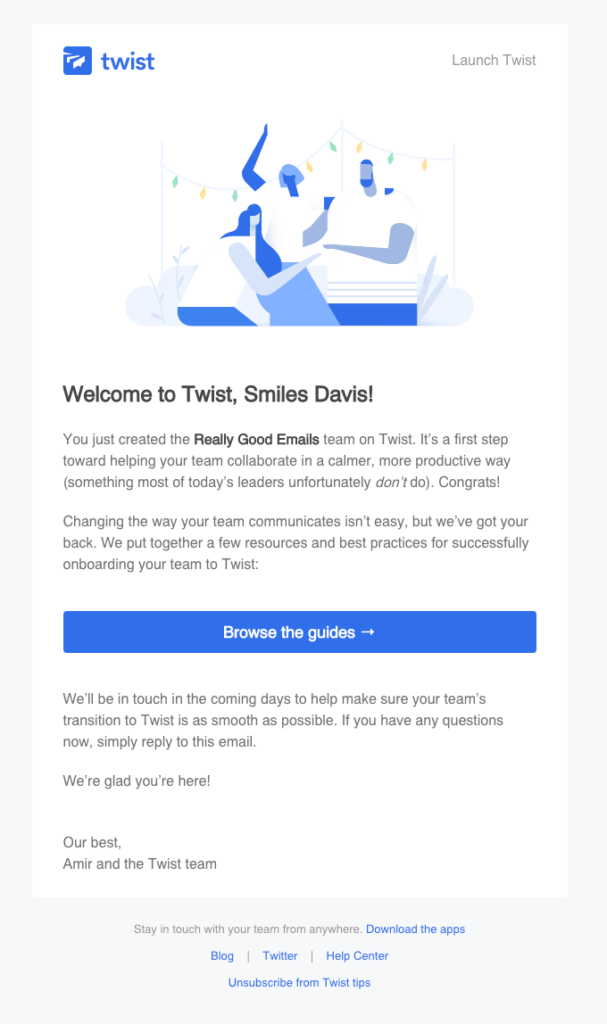As a customer success professional, you’ve sent your fair share of emails. And like most first impressions, your first email exchange with a prospect can set the tone for the entire relationship.
It’s like extending a hand for a firm, friendly handshake — it needs to be just right. But sometimes, despite your best efforts, your email doesn’t get the attention it deserves. It’s left unopened, or in some cases, it might lead to a lost subscriber. This represents a significant missed opportunity to connect and can prompt a reevaluation of your approach.
What if there was a way to ensure your email gets opened, appreciated, and acted upon?
In this article, we’re going to tackle this challenge head-on. We’ll explore the nuances of crafting emails that resonate with your audience and give you templates that blend professionalism with a personal touch — the kind that opens doors and builds lasting relationships.
Skip Ahead:
- What makes a great customer success manager introduction email?
- Template 1: The warm welcome
- Template 2: The informative introduction
- Customizing your template
- Best practices for follow-up emails
- Common mistakes to avoid
- Enhancing email marketing with CRM integration
- Conclusion
What makes a great customer success manager introduction email?
Crafting an introduction email that resonates with your clients goes beyond following a standard template — it’s about immediately striking the right chord. Here, we break down the components that make up an effective introduction email for a Customer Success Manager.
Personalization and tone
The essence of an impactful introduction email lies in its personalization. It should start with the basics, like addressing the client by name, and extend to acknowledging specific details about their business or their unique challenges.
The tone of the email should be warm and empathetic, reflecting a balance of professionalism and approachability. Imagine a conversation over coffee with a colleague — knowledgeable yet friendly, where the client feels heard and understood.
Clarity and brevity
In today’s fast-paced world, the clarity and brevity of your message are as crucial as its content. The introduction needs to be direct and to the point, focusing on the essentials.
Outline who you are, your role, and how you intend to support the client’s journey. The goal is to provide a clear and concise overview — a roadmap guiding the client on what to expect and how they benefit from your collaboration.
Call to action
A well-crafted call to action (CTA) is the bridge that turns an introduction into an ongoing conversation. The CTA should be clear, compelling, and designed to motivate the client to engage further.
Whether it’s an invitation to schedule a call, a prompt to access a resource, or a simple request to reply to the email, the CTA is a critical component that encourages continued interaction and fosters a collaborative relationship. It’s about more than concluding your message — it’s about opening the door to future communications and laying the groundwork for a strong working relationship.
Template 1: The warm welcome
A warm welcome can set the stage for a long-lasting, engaging relationship with your users. Statistics show that welcome emails have a 63.91% open rate, underscoring the potential of this initial interaction. This moment is critical as users are engaged and receptive to what you have to say.
Focusing on building a relationship rather than pushing a hard sell is essential in this crucial phase. Your email should be a genuine expression of welcome, introducing them to the community and seamlessly illustrating how your product can enhance their daily operations. This approach is not about overwhelming them with information but about guiding them to see the practical benefits of your offering in their everyday activities.
Consider Twist’s approach as a model: their welcome email effectively communicates the brand’s core value without overloading the user. The key here is using a single, focused Call to Action (CTA), simplifying the user’s decision-making process and encouraging them to take the next step. This strategy is about setting clear expectations and providing avenues for support, making the users feel guided and valued from the outset.

Source: Really Good Emails
Template 2: The informative introduction
The welcome email marks the beginning of your customer’s journey with your product. It’s important to keep the information in this email light and approachable, establishing a quick connection without overwhelming the customer.
Your objective here is to succinctly highlight your product’s value proposition. It’s about guiding your users to that moment of realization — the ‘Aha!’ moment when they see your product’s real value to their business. The email should be visually engaging, using branded color schemes and images or logos showcasing your product in action.

Source: Really Good Emails
Drawing inspiration from Playbuzz, note how their welcome email:
- Builds momentum and motivates users to take the next steps.
- Utilizes brand colors and experiments with font styles for a distinctive look.
- Employs friendly language to create a sense of familiarity and ease.
- Reinforces its unique value proposition, setting it apart from competitors.
- Includes well-placed CTAs at strategic points in the email, guiding users clearly on what to do next, and removing any potential confusion.
Customizing email templates for Customer Success Managers
While templates provide a solid foundation for your emails, customization is key to ensuring each message resonates with its recipient. Tailoring your emails to suit different clients and incorporating your company’s unique branding are crucial steps in crafting an email that informs and engages.
Adapting to different client types
Understanding the diversity of your clientele is vital. Each client comes with their own set of expectations, experiences, and needs. Customizing your email to address these unique aspects can greatly enhance the effectiveness of your communication. Here are a few tips:
- Identify the client’s background: Are they beginners in your field or seasoned veterans? Tailor your language and content complexity accordingly.
- Acknowledge their challenges: Reference specific challenges or goals relevant to their industry or business size.
- Personalize the solution: Highlight how your product or service specifically addresses their unique needs or challenges.
Incorporating company branding
Your emails serve as more than communication tools — they act as ambassadors of your brand. Ensure that your emails reflect your company’s personality and values. This includes:
- Consistent use of visual elements: Use logos, color schemes, and fonts that align with your brand’s visual identity.
- Tone and voice: Maintain a voice that mirrors your brand’s character — professional, friendly, innovative, or any combination thereof.
- Brand values and messaging: Reinforce your brand’s core values and messaging subtly within the content.
Best practices for follow-up emails
Crafting effective follow-up emails is a delicate art that plays a critical role in maintaining engagement and fostering enduring relationships with your clients. The strategic planning of these emails, focusing on their timing, frequency, and content, is pivotal in enhancing their impact and ensuring they serve as valuable touchpoints in the customer journey.
Timing and frequency
The effectiveness of follow-up emails is deeply intertwined with their timing and frequency. A well-timed follow-up can keep the conversation’s momentum going, reinforcing the connection established during the initial interaction. For instance, sending a follow-up shortly after a client interaction can help cement the relationship, showing attentiveness and a commitment to their needs.
Establishing a regular rhythm for your emails is also crucial. While consistent communication is key, balancing this with the risk of overwhelming your clients with too frequent messages is important. The cadence of these follow-ups should be thoughtful — enough to keep your clients engaged but not so much that it becomes intrusive.
Aligning your follow-up emails with key moments in the customer journey can significantly boost their relevance. For example, following up after a major product update or a significant milestone in the client’s journey with your product can provide timely and valuable information that aligns with their current experience.
Content strategy
The content of your follow-up emails is where the true opportunity for engagement and relationship-building lies. These emails should remind readers of your presence and valuable resources that contribute to your client’s experience with your product.
Including educational content like tips, guides, or insights can add tremendous value to your clients. This type of content can help them extract more value from your product, enhancing their experience and satisfaction. For example, a follow-up email with a brief guide on using a new feature can empower your clients and demonstrate your commitment to their success.
Updates and announcements are also important elements of follow-up emails. Keeping your clients informed about new features, changes, or relevant news about your company ensures transparency and keeps them in the loop, making them feel like a part of your brand’s journey.
Finally, integrating feedback and surveys into your follow-up emails can be incredibly beneficial. This provides valuable insights into your clients’ experiences and needs and makes them feel valued and heard. A follow-up email that asks for feedback on a recent update or seeks suggestions for improvement can foster a sense of community and collaboration, strengthening the client’s relationship with your brand.
Common mistakes to avoid
Navigating the nuances of customer success email communication can be challenging. Two common pitfalls are overwhelming clients with information and a lack of personalization. Addressing these issues is vital to developing effective and impactful communication.
Overwhelming information
When you’re passionate about your product or service, sharing every detail in your emails is tempting. However, an information overload can be counterproductive, leading to client disengagement.
The key is to balance enthusiasm with conciseness. For example, when introducing a new feature, focus on its most impactful benefits rather than delving into every technical detail. This approach allows the client to grasp the value without getting lost in the complexities.
Lack of personalization
In a world inundated with generic marketing messages, personalized communication stands out. The absence of personalization in your emails can make your message feel impersonal and disconnected from the client’s specific needs. Personalization goes beyond using the client’s name; it involves understanding and addressing their unique challenges and preferences.
Learn how to send promotional and non-promotional emails at the right time using marketing automation and AI predictive analytics tools from the marketing pros at Constant Contact.
Personalized Emails Using Marketing Automation and AI Predictive Analytics | Constant Contact
Incorporating advanced customer segmentation strategies can significantly enhance personalization. By analyzing customer behavior or lifecycle stages, you can tailor your emails to match their current needs and interests.
For example, a client just beginning their journey with your product might appreciate more educational content and step-by-step guides. In contrast, a long-term client might benefit more from advanced tips or information about new features. This level of personalization demonstrates not only your understanding of their journey with your product but also your commitment to providing relevant and valuable information at each stage.
Enhancing email marketing with CRM integration
Integrating a Customer Relationship Management (CRM) system into your email marketing, especially when crafting those crucial introduction emails, can really make a difference in connecting with your clients. It’s like having a secret ingredient that boosts engagement and helps pave the way for a successful relationship.
The role of CRM in email personalization
A CRM system goes beyond being a mere database — it unlocks insights that can revolutionize your email marketing efforts. Personalizing content to suit your audience is a critical aspect of successful email campaigns, and this is where a CRM system proves invaluable.
Businesses can create highly targeted email marketing campaigns by leveraging the rich data within a CRM. This focus on personalization shifts the spotlight onto the email recipient rather than a broad, generic audience, fostering more engaged customers and driving better profits.
CRM integration in email marketing
Many email marketing platforms today either offer seamless integration with CRM systems or have a built-in CRM component.
This integration enhances email marketing in several ways:
- Syncing lead and customer information: CRM integration ensures that all customer information is up-to-date across platforms, providing a unified view of the customer.
- Automated alerts for engagement: CRM systems can automate internal alerts for activities such as scheduled calls or follow-up emails, ensuring timely and relevant communication.
- Visibility into the sales funnel: Understanding where a customer is in the sales funnel is crucial. CRM software provides this insight, allowing for more tailored email communication.
- Tracking customer history: A CRM system keeps a detailed history of a customer’s interactions with your business, which can inform the content and timing of your emails.
- Identifying potential customers: By analyzing the sales funnel, a CRM can help identify potential customers, making your email marketing efforts more targeted and efficient.
- Personalized campaigns based on detailed information: The depth of information available in a CRM allows companies to create highly personalized email campaigns that resonate with the recipient.
Incorporating CRM in introduction emails
When crafting an effective customer success manager introduction email, integrating CRM data can elevate the personalization aspect significantly. By accessing a client’s history, preferences, and stage in the sales funnel, the introduction email can be tailored to address specific needs and interests, making it informative and deeply relevant to the recipient.
Set your customers up for success.
The best way to keep your customers happy is to make sure they’re getting the results they want from your product or service. That takes knowledge, and a Customer Training LMS is the way to build that knowledge effectively at scale.
A Customer Training LMS Software will help you retain customers by keeping them engaged. Learn more about how you can achieve this with Thinkific Plus.
Conclusion
Thank you for exploring the intricacies of effective email communication in customer success with us.
If you’re ready to take your email strategy to the next level and receive personalized guidance to streamline your email marketing efforts, don’t hesitate to reach out for expert advice.
Request a call with a member of our Thinkific Plus solutions team today, and let us help you unlock the full potential of your customer success journey.





